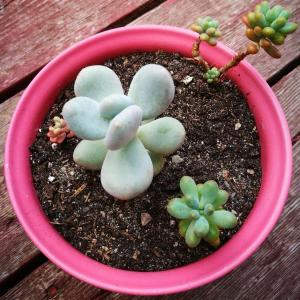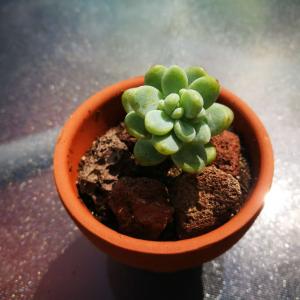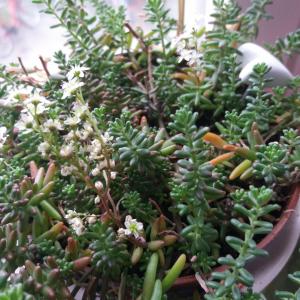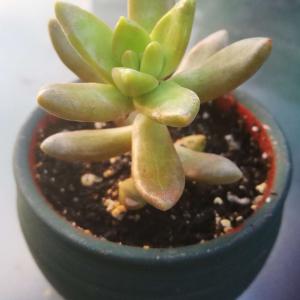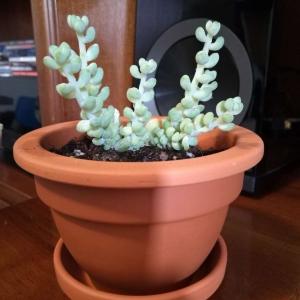成长记
Ueca
2017年08月30日

I new added a "Sedum pachyphyllum" in my "garden"


2
0
meriunkat:oh my goodness those are some beautiful colors!
Ueca
2017年08月22日

An arrangement incorporating Echeveria, Sedum, Crassula, Graptopetalum, and Kalanchoe.


1
0
文章
Dummer. ゛☀
2017年08月15日

Burro’s tail cactus (Sedum morganianum) is not technically a cactus but a succulent. Although all cacti are succulents, not all succulents are cactus. Both do have similar requirements such as gritty soil, good drainage, sunshine and protection from extreme cold temperatures. Growing burro’s tail provides fascinating texture as a graceful houseplant or lush green exterior plant in many landscape situations.

Burro’s Tail Information
Burro’s tail is a heat and drought tolerant plant well suited for warm to temperate regions. The thick stems appear woven or plaited with leaves. The succulent is green to gray green or even blue green and may have a slight chalky look. Try a burro’s tail houseplant or use it on the patio or full sun garden bed.

Burro’s Tail Houseplant
The misnamed burro’s tail cactus produces long, sweeping stems that are arrayed with thick, fleshy green leaves. The succulent thrives indoors in a well-drained container where bright sunlight bathes the plant. A burro’s tail houseplant will grow equally well in a mixed succulent container or as a hanging specimen. Slowly introduce the plant to full sun once purchased to allow it to acclimate first, as light conditions vary from nursery to nursery, etc. Provide even moisture and fertilize with cactus food during the growing season. Divide the plant when it gets too large for a container and transplant it every couple of years to provide it with fresh nutrient-rich soil. Burro’s tail care is easy and makes it an excellent plant for the novice gardener.

Burro’s Tail Propagation
Burro’s tail features long stems laden with small, rounded leaves. The leaves fall off at the slightest touch and will litter the ground after transplanting or repotting. Gather the leaves and insert them partway into a moist soilless medium. Burro’s tail plants can tolerate periods of drought, but the new potential plants need to be kept lightly moist until they root and establish. Propagating burro’s tail will ensure multiple enough of this versatile plant to play with and apply to many different indoor or outdoor landscaping situations. Propagating will also make numerous starts to share with friends and family or spread around the garden. Growing Burro’s Tail Outdoors One of the most fun plants around, this succulent is simple to grow. Outdoor plants may need winter protection with a light layer of mulch to protect them from cold. Plant the burro’s tail in full sun where there is shelter from drying and damaging winds.

Growing Burro’s Tail Outdoors
One of the most fun plants around, this succulent is simple to grow. Outdoor plants may need winter protection with a light layer of mulch to protect them from cold. Plant the burro’s tail in full sun where there is shelter from drying and damaging winds.

Burro’s Tail Care and Uses
The frequent traveler or green thumb-challenged garden will find burro’s tail care ideal. Water carefully when growing burro’s tail. Keep the plant moderately and evenly moist. Excess water can cause the stems to rot and even kill the succulent. Burro’s tail works well in a hanging basket and decorates a mixed cactus and succulent container. It will flourish in rockery cracks and makes a unique ground cover. Try planting the bushy stems in a bed with mixed seasonal color or bright flowering perennials. It is a perfect choice for large leaved plants and useful as part of a xeriscape garden.

Burro’s Tail Information
Burro’s tail is a heat and drought tolerant plant well suited for warm to temperate regions. The thick stems appear woven or plaited with leaves. The succulent is green to gray green or even blue green and may have a slight chalky look. Try a burro’s tail houseplant or use it on the patio or full sun garden bed.

Burro’s Tail Houseplant
The misnamed burro’s tail cactus produces long, sweeping stems that are arrayed with thick, fleshy green leaves. The succulent thrives indoors in a well-drained container where bright sunlight bathes the plant. A burro’s tail houseplant will grow equally well in a mixed succulent container or as a hanging specimen. Slowly introduce the plant to full sun once purchased to allow it to acclimate first, as light conditions vary from nursery to nursery, etc. Provide even moisture and fertilize with cactus food during the growing season. Divide the plant when it gets too large for a container and transplant it every couple of years to provide it with fresh nutrient-rich soil. Burro’s tail care is easy and makes it an excellent plant for the novice gardener.

Burro’s Tail Propagation
Burro’s tail features long stems laden with small, rounded leaves. The leaves fall off at the slightest touch and will litter the ground after transplanting or repotting. Gather the leaves and insert them partway into a moist soilless medium. Burro’s tail plants can tolerate periods of drought, but the new potential plants need to be kept lightly moist until they root and establish. Propagating burro’s tail will ensure multiple enough of this versatile plant to play with and apply to many different indoor or outdoor landscaping situations. Propagating will also make numerous starts to share with friends and family or spread around the garden. Growing Burro’s Tail Outdoors One of the most fun plants around, this succulent is simple to grow. Outdoor plants may need winter protection with a light layer of mulch to protect them from cold. Plant the burro’s tail in full sun where there is shelter from drying and damaging winds.

Growing Burro’s Tail Outdoors
One of the most fun plants around, this succulent is simple to grow. Outdoor plants may need winter protection with a light layer of mulch to protect them from cold. Plant the burro’s tail in full sun where there is shelter from drying and damaging winds.

Burro’s Tail Care and Uses
The frequent traveler or green thumb-challenged garden will find burro’s tail care ideal. Water carefully when growing burro’s tail. Keep the plant moderately and evenly moist. Excess water can cause the stems to rot and even kill the succulent. Burro’s tail works well in a hanging basket and decorates a mixed cactus and succulent container. It will flourish in rockery cracks and makes a unique ground cover. Try planting the bushy stems in a bed with mixed seasonal color or bright flowering perennials. It is a perfect choice for large leaved plants and useful as part of a xeriscape garden.
1
0
文章
Miss Chen
2017年08月08日


Golden Sedum (Sedum adolphi) is a low-growing succulent plant with pointed dark green leaves. The leaves develop orange or reddish tips when exposed to bright sunlight. Sedum adophi produces white, star-shaped flowers in spring. It can survive a few hours in temperatures as low is 29 degrees Fahrenheit, but is not considered winter hardy except in frost-free locations, such as United States Department of Agriculture plant hardiness zone 10 and warmer. Sedum adolphi is most often grown as a houseplant or an attractive outdoor container plant where it can be protected during the winter.
Step 1
Purchase a well-draining container for planting Sedum adolphi. The container should not be any bigger than 2 inches more in diameter than the root section of the plant. A larger container will contain more potting soil than is needed for the plant to grow. Unused potting soil collects moisture and the organic material in the potting soil will create fungal problems that can spread to the plant.
Step 2
Fill the bottom of the container with 1 inch of fine gravel. The gravel helps the container drain so it does not hold water. A Sedum adophi plant cannot sit in waterlogged soil or the plant will rot.
Step 3
Add potting soil until the container is half full. Carefully take the sedum from the previous container and plant in the new container. Add more potting soil around the Sedum adolphi until it is planted at the same depth it was planted in the previous container and the soil surface is 1 inch below the top of the container. Add water over the soil to settle the potting soil. Add more potting soil as needed. Spread a 1/2-inch layer of gravel over the potting soil. Leave a 1/2-inch space between the gravel and the top of the container so soil and gravel will not wash from the container during watering.

Step 4
Water the Sedum adolphi when the soil in the container is dry. Test the soil for dryness by pushing your finger through the gravel mulch into the top inch of soil. Water heavily until water runs from the bottom of the container.
Step 5
Fertilize once a month with a one-fourth strength solution of water soluble fertilizer appropriate for container plants. Only fertilize during the spring and summer months when the plant is actively growing.
Step 6
Place the container in which the Sedum adolphi is planted in a brightly lit location in the house. Outdoors, place the Sedum adolphi where it is protected from the hottest afternoon sun. Direct sun in the first part of the day followed by shade or dappled sun is best.
1
2


